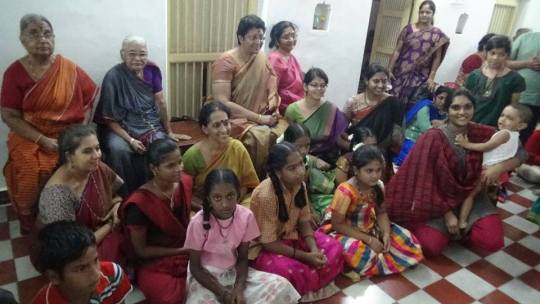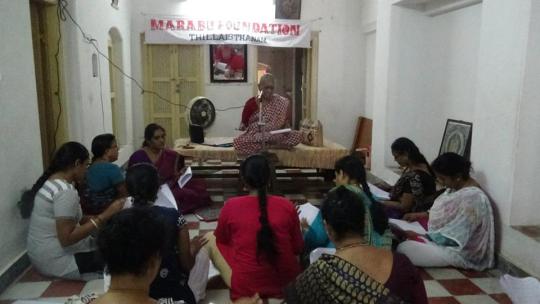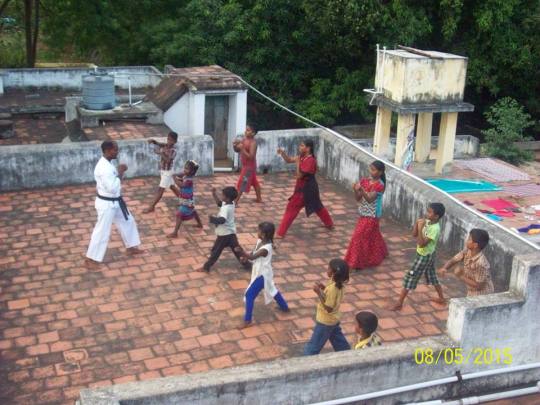Video
Kathakali (literally translated as story-play) is a highly stylised classical drama which evolved to its present form sometime in the 16th-17th Century CE, around the same time that Shakespeare was writing his plays in London. The switch in storytelling from Sanskrit to Sanskritized Malayalam took Kathakali to the masses and it spread far and wide, and today it is synonymous with the cultural heritage of Kerala.
Thus did Kathakali as an individual style of dance-drama emerge as ‘people’s theatre’ from the traditional dances of the past. The plays were performed by the Rajah’s own company of actors not only in temples and courts but from village to village and house to house. The new art form (called ‘Ramanattam’ - ‘”Rama” from the Ramayana and ”attam” meaning dance) soon became very popular all over the Malayalam speaking area. The feudal chieftains of Malabar (as the area was then called) began to vie with one another in their efforts to produce the best Kathakali troupes, and this competition contributed to the rapid development of the art in a very short period. One important result of this development was the composition by the Rajah of Kottayam, in North Malabar, of four plays in verse based on stories from the more colourful Hindu epic, Mahabharata. These are regarded by many connoisseurs as the best examples of Kathakali literature.”
(The above excerpt is from the book “A Guide to Kathakali” by David Bolland.)
The bright and colourful make-up, flowing costumes, percussion music, coordinated hand and eye movements of the artistes, have always appealed to both locals as well as tourists. However, most viewers tend to disconnect once the performance has started. This is largely because of the lack of understanding of: 1. The Language - which is Sanskritized Malayalam 2. The Story - from the Hindu epics like Ramayana, Mahabharata, Bhagavata Purana.
The real thrill of watching a Kathakali performance however is when it is conducted open-air. They start late in the evening and continue until dawn. As night falls, the shadow effect created by the lone, tall, oil lamp and the reverberation of the music and the open air setting makes for a thrilling experience. The stories on which Kathakali is performed has also evolved. In recent times “The life of Jesus Christ” and “Shakespeare’s Othello” was performed by Kathakali artistes. This is a very good trend and will help Kathakali become a more global art form.
The Kathakali artistes don’t speak heir dialogues they only communicate through mudras (hand gestures) and facial expressions what the singers sing in the background. The artiste uses the mudras to explain each and every word sung by the singer, which we can pick up if we pay close attention. The make-up of the character also reveals the role played and helps in connecting with the story-line, see images and accompanying text above.
Kathakali had been an all-male art form for a very long time, with even women characters being portrayed by men. In a State which is known for its high female to male ratio, matrilineal lineage and high literacy rates, entry barriers for women into the Arts were high.
Our Women of Kathakali in Kochi, Kerala, is a special interest tour that offers an unique opportunity to meet a group of highly spirited women Kathakali artistes who broke through the male bastion, excelled in the art and made a mark for themselves. They share with us their inspiring journey of starting an all women Kathakali troupe while alongside explaining the different elements of this fascinating art form- its stories, language, costumes, music, training, mythology, et al. The interaction ends with a brief lecture-demonstration without any make-up or costume.
For more details write to us at [email protected] or call +91 99404 58435.
1 note
·
View note
Video
As India celebrates #Diwali, the festival of lights, here's a look at one (of many) Indian ritual/folk art forms that is totally dependent on light. 'Thol-pava-koothu' is a ritual art form performed in or near Goddess temples in and around #Palakkad district (Central Kerala). Oil is filled in coconuts and then lit up. 'Thol' means leather, 'Pava' means puppet and 'Koothu' means play. Tholpavakoothu is thus the staging of plays with leather puppets. Modern versions last a few hours, however elaborate ritualistic versions can last up to 42 days! The light from these art forms though are on the verge of getting extinguished, forever, unless you and me pitch in. This is true of the hundreds of art forms across India. How about visiting or inviting one of these performers for your next Company event or at your residential associations upcoming New Year party or maybe even your, or a close ones, wedding party. It can have a huge impact. Think about it. You can also enquire locally and visit these artistes when on a holiday. Let's do whatever little we can while its still possible. Happy Diwali to all of you and to your loved ones. :-) #tholpavakoothu #ritualarts #folkarts #soundsofmalabar #corporateevents #weddingideas #indianrituals #indianfolkart #specialinteresttours #diwalispecial #deepavali https://www.instagram.com/p/BpzTruanoIc/?utm_source=ig_tumblr_share&igshid=x5jhtnvobg4t
#diwali#palakkad#tholpavakoothu#ritualarts#folkarts#soundsofmalabar#corporateevents#weddingideas#indianrituals#indianfolkart#specialinteresttours#diwalispecial#deepavali
0 notes
Video
The Malabar region (Northern Kerala) is rich in its ritual, folk and contemporary traditions. As much as these traditions capture our imagination with their simplicity or highly elaborate preparations, the lives of their (hereditary) performers are very closely interlinked. That is a story worth knowing, and is what makes the performance meaningful for us as an audience. Have you visited Malabar Kerala as yet? "Thuyilunarthu Pattu" is performed by the descendants of the Malayan Raja (Kutty) family belonging to the Pana tribal community who are based out of Malappuram. While the Songs (Pattu) speak about the legend of how Lord Shiva after losing consciousness on being struck by the dice thrown at him by Goddess Parvathi, and the Pana community members being the only one who can bring him back with their Pattu. For the community, and the descendants of the Malay Raja especially, the Pattu signifies the very important position given to them by the King of the erstwhile Valluvanad kingdom, in the annual festival at one of the most significant of Bhagavathi (Mother Goddess) temples in Kerala, the Thirumandhamkunnu Bhagavathi temple. On your next visit to Kerala consider visiting its Malabar region, you will be most delighted. #musicallyindia #soundsofmalabar #malabarlegends #specialinteresttours #tribalart #folkart https://www.instagram.com/p/Bps7V5wn0kK/?utm_source=ig_tumblr_share&igshid=15l6kty8wtcgw
1 note
·
View note
Photo

Sing Along
For Marabu Foundation 25.04.2015 was a red letter day.
Smt. Bombay Jayashree with her students from chennai visited Marabu Foundation on that day. Her simplicity and friendly mingling with the children were remarkable. When Marabu Children wanted to revise the last song learnt at previous Sing Along session. she immediately got herself ready for the session. Marabu Children sang the songs that they had already learnt from them. They also got revision of the song that they learnt during the previous sing along session. Marabu children, the simple village children, were very fortunate to learn directly from the great Bombay jayashree. Marabu children are happy for another reason : to meet Abinaya Akka again. They warmly enquired about Swetha Akka and Purnima Akka too.
0 notes
Photo

Workshop on Anandabairavi of Syama sastri was conducted successfully from 17th to 21st April 2015. Six krithis and one varna of Syama sastri was taught by Smt. S. Rajeswari and Smt.Syamala Venkateshwaran.Both resource persons apart from teaching the compositions explained the important sancharas in the respective compositions. On the concluding day( Syama Sastri Jeyanthi day) Sri.S.Sundar,Auditor, disturbuted the certificates to the participants. In the evening the venue was shifted to Bangaru Kamakshi Amman Temple,West Main Street,Thanjavur. The resource persons and participants of the workshop paid sangeetha Anjali to Syama Sastri. it was followed by Harikatha on Parvathi Kalyananam ( Compositions of Syama Sastri) by Smt. Vishaka Hari was held. The Presence of S.Raja descendant of syama sastri added more serenity to the occasion. Thank to the Sri .Sundar, Auditor, Chennia, for his kinds Sponsorship.
0 notes
Photo

Summer workshop for the children at Marabu Foundation is an annual feature. All these years the topics have been very carefully chosen to create awareness on our culture and forgotten elements which helped to make the children mentally and physically healthy. There should not be any strict schedule and timing of every program should be flexible, just to make a happy environment for a joyful learning.
0 notes